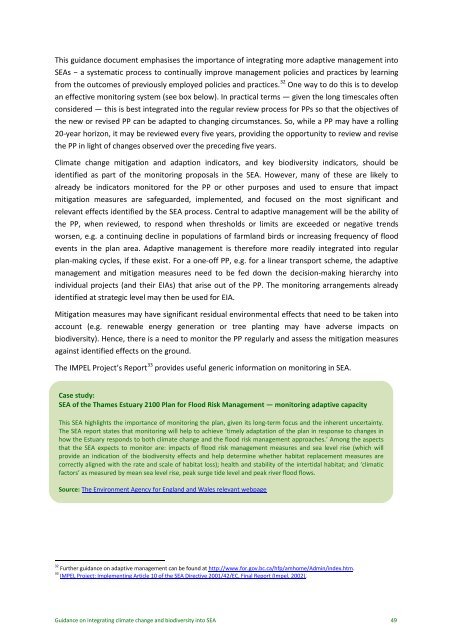Guidance on Integrating Climate Change and Biodiversity into ...
Guidance on Integrating Climate Change and Biodiversity into ...
Guidance on Integrating Climate Change and Biodiversity into ...
You also want an ePaper? Increase the reach of your titles
YUMPU automatically turns print PDFs into web optimized ePapers that Google loves.
This guidance document emphasises the importance of integrating more adaptive management <strong>into</strong>SEAs − a systematic process to c<strong>on</strong>tinually improve management policies <strong>and</strong> practices by learningfrom the outcomes of previously employed policies <strong>and</strong> practices. 32 One way to do this is to developan effective m<strong>on</strong>itoring system (see box below). In practical terms — given the l<strong>on</strong>g timescales oftenc<strong>on</strong>sidered — this is best integrated <strong>into</strong> the regular review process for PPs so that the objectives ofthe new or revised PP can be adapted to changing circumstances. So, while a PP may have a rolling20-year horiz<strong>on</strong>, it may be reviewed every five years, providing the opportunity to review <strong>and</strong> revisethe PP in light of changes observed over the preceding five years.<strong>Climate</strong> change mitigati<strong>on</strong> <strong>and</strong> adapti<strong>on</strong> indicators, <strong>and</strong> key biodiversity indicators, should beidentified as part of the m<strong>on</strong>itoring proposals in the SEA. However, many of these are likely toalready be indicators m<strong>on</strong>itored for the PP or other purposes <strong>and</strong> used to ensure that impactmitigati<strong>on</strong> measures are safeguarded, implemented, <strong>and</strong> focused <strong>on</strong> the most significant <strong>and</strong>relevant effects identified by the SEA process. Central to adaptive management will be the ability ofthe PP, when reviewed, to resp<strong>on</strong>d when thresholds or limits are exceeded or negative trendsworsen, e.g. a c<strong>on</strong>tinuing decline in populati<strong>on</strong>s of farml<strong>and</strong> birds or increasing frequency of floodevents in the plan area. Adaptive management is therefore more readily integrated <strong>into</strong> regularplan-making cycles, if these exist. For a <strong>on</strong>e-off PP, e.g. for a linear transport scheme, the adaptivemanagement <strong>and</strong> mitigati<strong>on</strong> measures need to be fed down the decisi<strong>on</strong>-making hierarchy <strong>into</strong>individual projects (<strong>and</strong> their EIAs) that arise out of the PP. The m<strong>on</strong>itoring arrangements alreadyidentified at strategic level may then be used for EIA.Mitigati<strong>on</strong> measures may have significant residual envir<strong>on</strong>mental effects that need to be taken <strong>into</strong>account (e.g. renewable energy generati<strong>on</strong> or tree planting may have adverse impacts <strong>on</strong>biodiversity). Hence, there is a need to m<strong>on</strong>itor the PP regularly <strong>and</strong> assess the mitigati<strong>on</strong> measuresagainst identified effects <strong>on</strong> the ground.The IMPEL Project’s Report 33 provides useful generic informati<strong>on</strong> <strong>on</strong> m<strong>on</strong>itoring in SEA.Case study:SEA of the Thames Estuary 2100 Plan for Flood Risk Management — m<strong>on</strong>itoring adaptive capacityThis SEA highlights the importance of m<strong>on</strong>itoring the plan, given its l<strong>on</strong>g-term focus <strong>and</strong> the inherent uncertainty.The SEA report states that m<strong>on</strong>itoring will help to achieve ‘timely adaptati<strong>on</strong> of the plan in resp<strong>on</strong>se to changes inhow the Estuary resp<strong>on</strong>ds to both climate change <strong>and</strong> the flood risk management approaches.’ Am<strong>on</strong>g the aspectsthat the SEA expects to m<strong>on</strong>itor are: impacts of flood risk management measures <strong>and</strong> sea level rise (which willprovide an indicati<strong>on</strong> of the biodiversity effects <strong>and</strong> help determine whether habitat replacement measures arecorrectly aligned with the rate <strong>and</strong> scale of habitat loss); health <strong>and</strong> stability of the intertidal habitat; <strong>and</strong> ‘climaticfactors’ as measured by mean sea level rise, peak surge tide level <strong>and</strong> peak river flood flows.Source: The Envir<strong>on</strong>ment Agency for Engl<strong>and</strong> <strong>and</strong> Wales relevant webpage32 Further guidance <strong>on</strong> adaptive management can be found at http://www.for.gov.bc.ca/hfp/amhome/Admin/index.htm.33 IMPEL Project: Implementing Article 10 of the SEA Directive 2001/42/EC, Final Report (Impel, 2002).<str<strong>on</strong>g>Guidance</str<strong>on</strong>g> <strong>on</strong> integrating climate change <strong>and</strong> biodiversity <strong>into</strong> SEA 49
















